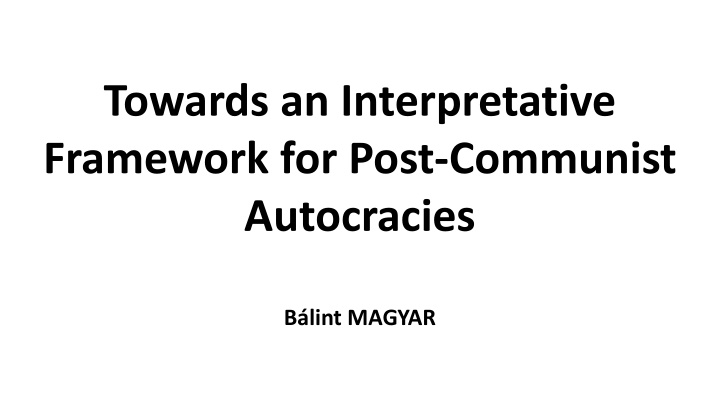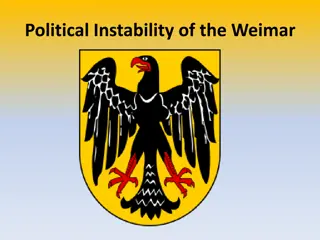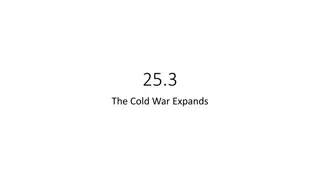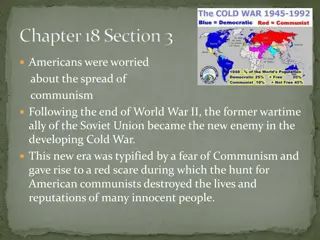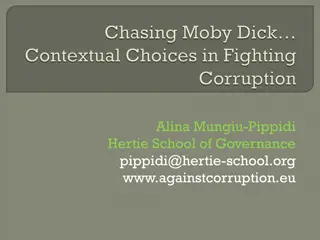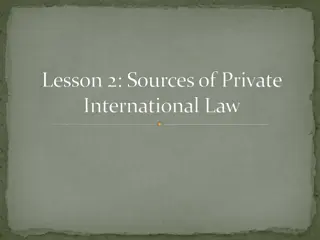Framework for Understanding Post-Communist Autocracies
The illusion of linear progress towards liberal democracies post-1989-1990 revolutions is challenged by the complex reality of post-communist autocracies. This framework explores the characteristics of democracy, autocracy, and dictatorship to categorize regimes, highlighting the challenges and nuances in the transition from communist rule. Various forms of authoritarianism, electoral democracy, and hybrid regimes are analyzed within the democracy-dictatorship axis to provide a comprehensive understanding of political systems in post-communist countries.
Download Presentation

Please find below an Image/Link to download the presentation.
The content on the website is provided AS IS for your information and personal use only. It may not be sold, licensed, or shared on other websites without obtaining consent from the author.If you encounter any issues during the download, it is possible that the publisher has removed the file from their server.
You are allowed to download the files provided on this website for personal or commercial use, subject to the condition that they are used lawfully. All files are the property of their respective owners.
The content on the website is provided AS IS for your information and personal use only. It may not be sold, licensed, or shared on other websites without obtaining consent from the author.
E N D
Presentation Transcript
Towards an Interpretative Framework for Post-Communist Autocracies B lint MAGYAR
Illusion of linear progress towards liberal democracies after the change of the political regimes in 1989-1990; that any regime can be built on any kind of ruins of communist dictatorships. Transitional systems or terminal stations?
The DemocracyDictatorship Axis Liberal democracy Dictatorship Hybrid regimes Liberal democracy Electoral democracy Competitive authoritarianism Hegemonic authoritarianism Closed authoritarianism Autocracy Democracy Dictatorship First categorization: Andr s Boz ki and D niel Heged s, An Externally Constrained Hybrid Regime: Hungary in the European Union, Democratization, April 13, 2018, 1 17. Second categorization: Marc Morj Howard and Philip G. Roessler, Liberalizing Electoral Outcomes in Competitive Authoritarian Regimes, American Journal of Political Science 50, no. 2 (April 1, 2006): 367. Third categorization: J nos Kornai, The System Paradigm Revisited, Acta Oeconomica 66, no. 4 (1, 2016): 565.
Jnos Kornai: Characteristics of Democracy, Autocracy, and Dictatorship (Primary features) Democracy Autocracy Dictatorship 1 The government can be removed through a peaceful and civilized procedure 2 Institutions which concertedly guarantee accountability are well- established 3 Legal parliamentary opposition exists; multiple parties run for elections 4 No terror (large-scale detention in forced-labor camps and executions) The government cannot be removed through a peaceful and civilized procedure Institutions which could concertedly guarantee accountability are either formal or weak Legal parliamentary opposition exists; multiple parties run for elections The government cannot be removed through a peaceful and civilized procedure Institutions which could allow/guarantee accountability do not exist No legal parliamentary opposition; only one party runs for elections Terror (large-scale detention in forced-labor camps and executions) P R I M A R Y No terror (large-scale detention in forced-labor camps and executions), but various means of coercion are used against political adversaries (imprisonment with false allegation, or politically motivated murder)
Jnos Kornai: Characteristics of Democracy, Autocracy, and Dictatorship (Secondary features) Democracy Autocracy 5 No repressive means are used against parliamentary opposition parliamentary opposition 6 Institutions of checks and balances are active and independent independent 7 Relatively few officials are appointed by the ruling political group offices 8 Civil protest against the government has no legal boundary; strong civil society society 9 Interested persons and their organizations take part in many forms and to relevant degrees in preparations for decision-making (significant levels of participation) 10Freedom of the press is guaranteed by law, and is actually enforced Dictatorship Repressive means are used against No parliamentary opposition Institutions functioning as checks and balances are weak and non- No institutions have been created to act as checks and balances S E C O N D A R Y The ruling political group appoints its own cadres to virtually all important The ruling political group appoints its own cadres to all important offices Civil protest against the government is prohibited by law Civil protest against the government has no legal boundary; weak civil There are legal frameworks for participation but they are practically dysfunctional Participation is not even formally prescribed Freedom of the press is constrained by legal and economic means No freedom of the press
Post-communist countries by political institutional system (J nos Kornai) Democracies Autocracies Dictatorships Albania, Bulgaria, Croatia, Czech Republic, Estonia, Georgia, Latvia, Lithuania, Macedonia , Moldova, Poland, Romania, Serbia, Slovakia, Slovenia, Ukraine Armenia, Azerbaijan, Belarus, Hungary, Kazakhstan, Kyrgyzstan, Russia, Tajikistan, Turkmenistan, Uzbekistan China, Vietnam, North Korea
Stubborn structures Lack of separation of spheres of social action Informal networks Collusion of power and ownership Patrimonialization Patron-client relations Centralized/monopolized forms of corruption
The problems with the purely political institutional approach Under each category, there is a heterogeneous set of cases. It sticks to the political level, disregarding the stubborn sociological and economic structures connected to it. How can we incorporate into the typology of Post- Communist regimes further dimensions? ownership relations; economy; structure of the ruling elite?
Interpretative Framework of Post-Communist Regimes (combining the political, economic and sociological dimensions) Conservative autocracy Liberal democracy Communist dictatorship (Estonia, Czech Republic) (North Korea) Patronal democracy Market-exploiting dictatorship (Bulgaria, Romania) (China, Vietnam) Patronal autocracy (Hungary, Russia, Central-Asian Rep.)
Who is the actor? Interpretative layers of categories to describe the mafia state The type of state State (operated by formal institutions) Network state Interpretive layers of the category To which features of the state the category refers to Institution by which the ruling elite exercises legitimate coercion Monopoly on the right to authorize the legitimate use of violence 1. 1st feature + increasing informal character of the connections within and between the units of the state 1st + 2nd features + the personal, patronal, hierarchically dependent character of the ruling elite 1st + 2nd + 3rd features + the adopted political family (political-economic clan) structure of the ruling elite The ruling elite s exercising power through mainly informal power network The ruling elite s internal dependency, patron-client relations (patronal power network) The ruling elite s anthropological structure and cultural patterns 2. Patronal state 3. Clan state 4.
What is the action? Interpretative layers of categories to describe the mafia state The type of state Interpretive layers of the category To which features of the state the category refers to Monopoly of taxation (tax, rent, etc.) for maintaing public functions Primary source of state revenues 1. State (driven by public good) 1st feature + legal overtaxing in favor of public or private actors Favoritism to expand state bureaucracy for supporters 2. Rent-seeking state 1st + 2nd features + non-legal diverting of current incomes to private hands Illegal favoritism 3. Kleptocratic state 1st + 2nd + 3rd features + expropriation of property using non-legal state coercion Illegal predation 4. Predatory state Internal dimensions: public policy vs. private goals; normative vs. discretional; legal vs. non-legal
Is the action legal? Interpretative layers of categories to describe the mafia state The type of state Interpretive layers of the category To which features of the state the category refers to Monopoly of taxation (tax, rent, etc.) for maintaing public functions Primary source of state revenues 1. State (respecting the consitution) 1st feature + the abuse of entrusted power for private gain (occasional, non- stable chains of vassalage) Corruption = deviant element of the system 2. Corrupt state 1st + 2nd features + chains of corrupt vassalage with a permanent character Corruption = structural element of the system 3. Partially captured state 1st + 2nd + 3rd features + subordinated to and monopolized by a political enterprise (governance led as a criminal organization) Corruption = constituting element of the system 4. Criminal state
Patronage Politics: State Functions Subordinated to Private Interests: the Post-Communist Mafia State The basis for the term used Alternative terms used for the description of patronage in post- communist regimes 1. Actor clan state 2. Action (targeting power resources) 3. Action (targeting rents and goods) 4. Legality neopatrimonial state Post-Communist Mafia State predatory state criminal state
Key system components and actors in three ideal-type political regimes Liberal democracy Post-communist patronal autocracy Communist regime head of the executive power (president / PM) govern (within formal authorization) chief patron (patronal presidentialism) dispose (beyond formal authorization) general party secretary command (within formal authorization) government autonomouselites multi-party system political party governing party democratic party politician patron s court adopted political family dominant-party system patron s party transmission belt party vassal party poligarch (political enterpreneur) / political stooge patronal servant politburo nomenklatura one-party system state party cadre party centralised party high level party cadre/functionary public servant administrative cadre a (apparatchik) state enterprise leader , pusher plan or barter bargain entrepreneur lobbyist business interest representation oligarch / minigarch corruption broker facilitating corrupt exchange not applicable economic stooge (strohmann) not applicable
Four evolutionary stages of corruption Systemic or non- systemic Horizontal Non- centralised Competitive Voluntary Ad hoc Kickback money Petty Corrup- tion Systemic or non- systemic Parallel verticals (bottom-up) Moderately centralised Oligopolistic / local or vertical monopolies Voluntary / coercive Temporary / partial dependency Kickback money Oligarchic state capture Systemic or non- systemic Parallel verticals (top-down) Partially centralized Oligopolistic / local or vertical monopolies Voluntary / Coercive Permanent / partial dependency (vassal chains) Protection money Party state capture Systemic Single vertical (top- down) Centralised Monopolistic Coercive Permanent / general dependency (vassal chains) Protection money Criminal state
Patterns of corruption in three ideal-type political regimes Liberal democracy Post-communist patronal Communist regime autocracy competitive market corruption relational market corruption administrative market corruption surplus corruption n.a. shortage corruption sellers corruption system destroying corruption corrupting individuals, firms + organized underworld n.a. system constituting corruption organized upperworld + organized underworld + corrupting individuals protection money + kickback money selectively preferred ( , roof ) or sanctioned buyers corruption system lubricating corruption corrupting individuals kickback money + protection money generally/normatively sanctioned kickback money moderately tolerated
Types and some features of reiderstvo in post-communist regimes Strength of the state Legitimacy of raiding The initiator or client of the corporate raiding Organized upperworld: chief patron (top level public authority) Low or middle level public authority Rival entrepreneurs or oligarchs Organized underworld: criminal groups XXXXXXXXXXXXXXXXX XXXXXXXXXXXXXXXXX XXXXXXXXXXXXXXXXX White raiding Strong state I I I I Weak state XXXXXXXXXXXXXXXXX XXXXXXXXXXXXXXXXX XXXXXXXXXXXXXXXXX XXXXXXXXXXXXXXXXX XXXXXXXXXXXXXXXXX XXXXXXXXXXXXXXXXX Gray raiding XXXXXXXXXXXXXXX XXXXXXXXXXXXXXXXX XXXXXXXXXXXXXXX XXXXXXXXXXXXXXX XXXXXXXXXXXXXXX Crime Black raiding Criminal state Single-pyramid patronal system Monopolized Market and oligarch capture State crime Corporate crime Multi-pyramid patronal system Institutional environment and features of the raiding action Oligarchic Competitive Partial state capture
Social/economic integration schemes/coordinating mechanisms in three ideal-type political regimes Capitalist system Socialist system Market economy Relational economy Planned/command economy Socially/politically disembedded economy Patronally embedded economy Bureaucratically embedded economy Dominant integration scheme/coordinating mechanism Competitive market Relational Burocratic market-redistribution resource-redistribution regulated impersonal normative dominant non-formalized personal discretional dominant formalized impersonal normative general/total Invisible hand of the impersonal market forces Visible hand of the patron interfering with market forces Central planning of the nomenklatura bypassing market forces Horizontal Vertical Vertical
Administrative market Mechanisms of coordination Actors of transaction Goods of transaction Main mechanism of coordination Burocratic resource- redistribution Authorised members of the nomenklatura Production and consumer inputs Admin.cadre Seller Private person Buyer Consumer goods Time Legal Queuing, waiting lists Party cadre Party cadre Admin.cadre Party cadre Administrative cadre State Enterprise Leader Production inputs loyalty Political influence, Plan bargain Correc- ting mecha -nisms Admin.cadre State Enterprise Leader Soft budget constraint budget constrait Future prod.inputs Illusion of hard Under-planning StateEnterprise Leader Leader State Enterprise Production inputs Production inputs Barter Administrative cadre Private person Seller Buyer Consumer goods Money Corruption Illegal
Competitive market Mechanisms of coordination Actors of transaction Goods of transaction Market coordination, price mechanism Main mechanism of coordination Private actors Goods and services State regulations and subsidies Political success Entrepreneur Politician Lobbying Legal Discount on goods/services evasion Tax Buyer Seller Grey market Entrepreneur servant Politician / public Freemarket corruption Distor- ting mecha -nisms Bureaucratic facilitation Bribe Police corruption Gangster Public servant Non-enforcementof law Bribe Futurestate protection financing Party Oligarch Party leader Party capture Partial state capture Illegal Oligarch, gangster Political elite State protection Bribe
Relational market Mechanisms of coordination Actors of transaction Goods of transaction Relational market redistribution Main mechanism of coordination Authorized membersof the adopted political family Power + ownership/revenues Servitude derived paid with from unconditional loyality position Political patronalization Poligarch patronal servant administr. Collusion of legal and illegal elements Annexing mecha- nisms Wealth to resources and markets discretional access Economic patronalization Poligarch strohmann oligarch/
Features of property rights in three ideal-type political regimes Liberal democracy Post-communist patronal autocracy private property power&ownership & competitive market relational market market economy relational economy competitive market relational market-redistribution Communist regime state property administrative market command economy bureaucratic resource redistribution centralised allocation: (re)distributing taking (taxation, rents, tribute, plunder) and rent-seeking (administrative, budgetary, natural resources) , grabitization trading and taxing privatization n.a. nationalization deprivatization, renationalization, patrimonialization nationalization / collectivization hostile takeover reiderstvo (centrally led corporate raiding) expropriation
Ownership rights Expropriation of endogenous rights Market economy Relational economy Result of patronalization /expropriation De jure = de facto Matching De jure =/= de facto Collusion(offshore, strohmann) Normative / persistent regulations Discretional / ad hoc regulations Politician Entrepre- neur Poligarch Front man, stooge Oligarch Endogenous rights The right to enter a defined physical property Access Use rights - + + + + to obtain the products of a resource With- drawal - + + - + - to regulate internal use patterns and transform the resource by making improvements Manage- ment Control rights - + + - + - + to determinate who will have an access right, and how that right may be transferred Exclusion - + + - + - to sell or lease the rights of management and exclusion Alienation - + + - + -
Interpretative Framework of Post-Communist Regimes Conservative autocracy Liberal democracy Communist dictatorship (Estonia, Czech Republic) (North Korea) Patronal democracy Market-exploiting dictatorship (China, Vietnam) (Bulgaria, Romania) Patronal autocracy (Hungary, Russia, Central-Asian Rep.)
The Place of Relational Market-Redistribution among Post-Communist Regime Types Coordinating mechanisms Normativity of state regulations Cons.aut. Cons.aut. Com. dict. Com. dict. Lib. dem. Lib. dem. Bureaucratic resource redistribution Price mechanism Normative Pat. dem. Pat. dem. Market-expl. Dict. Market-expl. Dict. Relational market- redistribution Discretional Pat. autoc. Pat. autoc.
Modelled Trajectories of Post-Communist Regimes: 1. Hungary Conservative autocracy Communist dictatorship Liberal democracy 1990-1998 Market-exploiting dictatorship Patronal democracy Patronal autocracy
Modelled Trajectories of Post-Communist Regimes: 2. Poland Conservative autocracy 1990-2015 Communist dictatorship Liberal democracy 2015- Market-exploiting dictatorship Patronal democracy Patronal autocracy
Modelled Trajectories of Post-Communist Regimes: 3. Romania Conservative autocracy Communist dictatorship Liberal democracy Market-exploiting dictatorship Patronal democracy Patronal autocracy
Modelled Trajectories of Post-Communist Regimes: 4. Ukraine Conservative autocracy Communist dictatorship Liberal democracy Market-exploiting dictatorship Patronal democracy Patronal autocracy
Modelled Trajectories of Post-Communist Regimes: 5. Russia Conservative autocracy Communist dictatorship Liberal democracy Market-exploiting dictatorship Patronal democracy Patronal autocracy
The formal position of the chief patron, the decision making body and the type of patronal networks in Russia The formal position of chief patron (as the head of executive power) tsar The ruling body (the decision making center) Ruling elite according to the type of patronal networks Type of the patronal state before 1917 court service gentry, feudal orders feudal state 1917-1991 party general secretary president politburo nomenklatura party state after 1991 patron s court adopted political family mafia state
Modelled Trajectories of Post-Communist Regimes: 6. Uzbekistan Conservative autocracy Communist dictatorship Liberal democracy Market-exploiting dictatorship Patronal democracy Patronal autocracy
Modelled Trajectories of Post-Communist Regimes: 7. China Conservative autocracy Communist dictatorship Liberal democracy Market-exploiting dictatorship Patronal democracy Patronal autocracy
The Ruling Elites in a Liberal Democracy: Autonomous Elites political administ- rative economic cultural media military
The Ruling Elite in a Communist Dictatorship: The Nomenklatura political secret service, military economic administrative cultural media
The Ruling Elite in a Patronal Autocracy: The Adopted Political Family cultural secret service, military economy administrative Political media
The separation of branches of power within the adopted political family Executive power Party background Economic power Media power Personal wealth Chief patron + + + + + Poligarch (1) + - - - + Poligarch (2) - + - - + Oligarch (1) - - + - + Oligarch (2) - - - + + Stooge - - - - +
The Ruling Elites in a Conservative Autocracy: Authoritarianism with Competing Other Elites political economic admi- nistra -tive secret service, military media cultural
The Ruling Elites in a Patronal Democracy: Competing Patronal Networks cultural economy administrative media Political (government) Political (opposition) secret service, military (1) s s., m (2)
The Ruling Elite in a Market-exploiting Dictatorship: Dominant Party Elite political economic adminis- trative secret service, military media cultural
